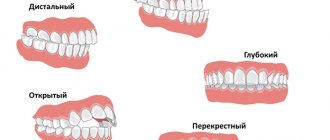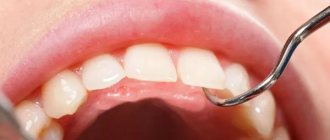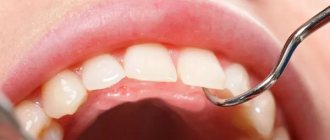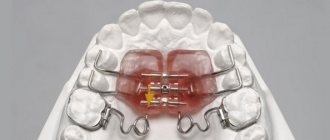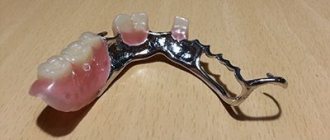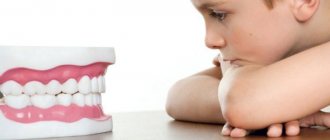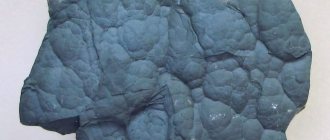4536
Bite correction during the period of changing primary teeth to permanent teeth occurs much easier and faster than moving row elements in adult patients.
For this reason, orthodontic treatment for children does not always require wearing visible and uncomfortable braces.
In most cases, the position of the teeth relative to the jaw line can be corrected using a removable structure - a plate equipped with a Bertoni screw.
General overview
The Bertoni screw is a fastening system that is an integral part of orthodontic leveling plates.
Made from plastic and metal alloy, which has excellent biocompatibility with natural tissues.
The thread and body of the element are made with maximum precision, and the surface of the rod is so smooth that the rotation of the thread and its sliding are very easy and do not cause additional inconvenience while wearing the device.
The design features of the screw completely eliminate its uncontrolled displacement. Main indications for use:
- change in the structure of the upper jaw row towards expansion. The best result can be achieved at the stage of formation of hard bone tissue, which occurs in childhood;
- for single or fragmentary movement of organs. The doctor sets the desired direction and distance within which the displacement must be achieved. These parameters determine the duration of the correction course.
Indications for installation
Such devices for straightening a row of teeth are used in childhood; braces are recommended for adults. Plates, depending on the curvature of the teeth and their location in the row, can be installed from the age of 6, when the first few molars grow.
If the defect is obvious, you need to contact an orthodontist as quickly as possible so that the teeth have time to properly move into place.
The main indications for installing plates are:
- minor malocclusion;
- abnormal arrangement of teeth in a row;
- the need to change the width of the palate;
- slowing down or activating tooth growth;
- rehabilitation after using braces (so that the teeth do not return to their previous state).
The formation of plates occurs only according to an individual impression of the patient’s palate. The same plate should not be used for more than one person.
In addition, as the child ages, such mechanisms undergo change or change, as the jaw grows and the position of the teeth changes.
The mechanism installation procedure is painless. You will immediately feel discomfort from a foreign object in your mouth, and your speech may change. But after some time a person gets used to the device.
In addition, if the plate is removable, you can take a break from it during meals. With a non-removable mechanism, it is important to carefully monitor it.
The first installation must take place under the supervision of a doctor, since there are errors in the manufacture of the structure. The time to get used to it ranges from 3 to 7 days.
You need to carefully care for the mechanism to avoid breakdowns and complications.
- Firstly, the structure is used to expand the upper jaw. This method is most effective at the time of bone tissue formation. Therefore, parents should be very attentive to their growing children and visit the orthodontist on time. The sooner you begin correction, if necessary, the more favorable the result.
- Secondly. The plate is used to move a single tooth or an entire row of teeth. The orthodontist determines the distance and direction in which the movement will be carried out. Depending on this, the duration of the course of treatment is adjusted.
There are no specific guidelines for the use of plates at a certain age. Their installation is possible both in early childhood and in adult patients. Most often, corrective braces are installed on children who have molars.
Many orthodontists recommend starting to correct the primary bite; just like the molars, there may be pathologies in location or angle of inclination. Plates are prescribed in the following situations:
- acceleration or deceleration of the processes of formation of jaw bones;
- correction of jaw shape;
- eliminating possible bias;
- changing the angle of one unit;
- correction of sky parameters;
- formation of a normal bite;
- preparing teeth and jaw bones for installation of braces;
- maintaining results after removing braces.
Dentists are of the opinion that it is advisable to correct the bite with corrective plates in children during the period of replacing baby teeth with permanent ones.
The video shows in which cases leveling plates are used.
Due to the simplicity of the design, there are no absolute contraindications to installation. Before installing the plate, the child undergoes a thorough examination of the oral cavity, evaluates the effectiveness of the use of retainers, and excludes malocclusions and complex deformations of the jaw bone.
The main contraindications include:
- allergic reactions to materials;
- course of periodontitis;
- pathologies of the development of the respiratory organs and respiratory tract;
- swallowing reflex disorders;
- mental illness;
- epilepsy.
During the course of some diseases, installation of corrective structures is possible, but the dentist together with specialized specialists can assess the risks of complications.
The huge advantage of orthodontic plates is that, despite their simplicity, they have a fairly wide range of options for use at a fairly low cost.
- Changing and correcting the shape of the jaw bones.
- Palate width correction.
- Consolidating the results of adjusting the position of teeth after removing braces.
- Preventing possible tooth displacement.
- Keeping jaws and teeth in their normal natural position.
- Stimulation or retardation of jaw growth.
- Relieving the dentition from pressure that can be exerted by the cheeks and lips.
- Widening of interdental spaces (baby teeth) to prevent torsion.
The list of contraindications is long at first glance. However, most of them are quite rare.
- Mental illnesses.
- Aggravated stage of periodontitis.
- Lack of proper oral hygiene.
- Allergic reactions (in this case, metal intolerance).
- Patient refusal of treatment.
- Some severe respiratory diseases.
Peculiarities
Plates with a Bertoni screw are selected individually, taking into account the anatomical features of the patient’s maxillofacial apparatus.
To obtain lasting positive dynamics, the device must be worn almost around the clock, removing it from the oral cavity only when necessary.
The fixation process occurs with the help of special hooks that are quite simply thrown over the teeth. This allows you to remove and put on the system yourself without the help of a specialist.
The principle of operation is to periodically tighten the screw mechanism, thus setting the required pressure force. As a rule, the doctor will do this the first time. Then, during the treatment process, the tension force of the metal arches is adjusted at home.
The Bertoni screw is the active part of the leveling structure. It has several independent guides, which makes it possible to adjust each sector independently. This allows you to stretch the teeth in the desired direction.
A special design advantage of the element is its three-dimensionality, which made it possible to combine two screws together - an expanding and an extending one. Thus, the plate itself has become significantly lighter and thinner.
What is the Brückle apparatus and the stages of its manufacture in the laboratory.
Let's talk here about the effectiveness of Ortho Snap aligners.
At this address https://www.vash-dentist.ru/ortodontiya/kapyi/nevidimyie-elayneryi-star-smile.html you will find reviews about Star Smile aligners.
Types of designs and their features
Various types of plates are used to correct malocclusion and eliminate other aesthetic and functional defects. Depending on their purpose, they can be removable or non-removable. There is also a classification by location: on the lower or upper jaw. There are monoblock, double-jaw devices.
Wearing devices that can be easily removed from the dentition if necessary is much easier for young patients to tolerate. This is due to the fact that if discomfort occurs, you can remove the arches from the mouth for a while and slightly delay the next tightening of the screw. However, it is important to remember that unpleasant sensations (difficulties with diction, minor pain) disappear after a few days. It’s better not to take anything out again. This is done only before tightening the teeth plate. If you allow your child to remove it too often, the treatment will not have any effect.
The orthodontist decides which mechanism is best suited in a particular case. Children are more often fitted with a Brückl or Frenkel apparatus. Constructions that are not removed until the end of the therapeutic course should only be adjusted by a doctor.
Fixed
The Ross plate is the most popular for correcting defects in patients aged 6 to 10 years. It is used to correct the upper dentition. Older children are often given braces, which are fixed in the presence of a permanent bite. The system includes plates with holes and locks, which are attached to the teeth using special dental glue and connected to each other by metal arches.
However, calling such structures plates is not entirely correct, since this is an independent type of orthodontic device.
Removable
For babies who still have baby teeth, devices are recommended that can be removed, which means they facilitate daily hygiene and can be taken out when eating and at any other time when it is required. Most often, orthodontists recommend the following types of structures:
- No active elements. Indicated when bite pathologies are minor. For example, if one canine or front incisor deviates.
- Substitutes. In most cases, it is used as a preventive measure to prevent pathologies if some temporary units fell out or were removed much earlier than expected. There are also non-removable versions. Sometimes the system includes artificial crowns, which temporarily replace the lost ones and imitate their presence in the oral cavity.
- Bruckle's apparatus. It is installed on the lower jaw, but also participates in the correction of the upper jaw.
- With active screw. Placed on both rows, they are the most common method of correcting curvature during the change from primary to permanent bite. It is in this case that regular twisting is required. The device is adjusted by parents according to a strictly established schedule, but under the constant supervision of an orthodontist. Let's look at how to tighten a dental plate with a dental key below.
Types of plates
There are three types of orthodontic leveling mechanisms, each of which has individual indications for use:
- standard plates - used for minor bite defects when serious correction of the anomaly is not required. An ideal solution for giving the correct direction of growth to individual dental elements;
- with the addition of active components - they effectively align fragmented lesions and more complex occlusion pathologies. Such structures have a screw mechanism that regulates the tension force of the plates, which actively influence the direction of tooth growth;
- designs with a Bertoni screw - got their name in honor of their developer.
They make the system as efficient as possible. The main indication for use is correction of children's bite. The plate is less convenient in comparison with analog versions, but the results are several times superior to them.
The video describes in detail the types and principles of operation of the plates.
Device characteristics
The product consists of a plastic base, in the center of which there is a screw made of a medical metal alloy. There are arcs along the edges.
Localized parallel to the area of the lateral dental fragments, the arches create the load necessary for the therapeutic effect.
The device is made of medium-hard plastic. The color can be any. In this case, the shape of the plate repeats the palatal relief.
The arc is made of nickel or titanium alloy, and has the ability to “remember” the direction given to it. The thickness of the wire may vary.
The device is attached to special hooks made of the same material as the arcs.
In a number of models, activators are built into the plate, with the help of which the system is controlled. This is very convenient because one device is used throughout the entire correction period.
What does an orthodontic screw in plates look like and what is it for?
In general, an orthodontic screw or lock is a factory-made mechanical element that is included in many orthodontic plates. It is usually made from stainless steel.
There are different types of screws, different in size, shape, and purpose - some are used only in structures for the upper jaw (Bertoni, Steiner). Many of them are capable of working in several directions at once: moving individual teeth, symmetrically and asymmetrically expanding, narrowing or lengthening the base of the apparatus in order to influence the dentition.
Screws are made up of several threaded pins and have a thickening in the center called a barrel. There are holes in the drum - through them the plate is activated with a special key, which the orthodontist gives to the patient after installing the device.
Preparing the child
Alignment of teeth using this method is indicated at the stage of mixed dentition in a child. At a later age, this procedure is ineffective. Baby teeth are more amenable to correction of anomalies when the pressure force is not too high.
Despite the fact that the correction itself is not a particularly complex manipulation, at all stages of treatment the child should be under the periodic supervision of a dentist.
This requirement is due to the fact that the placement of the organs has not yet been fully formed and incorrect use of the device can cause harm to the teeth, including their complete loss.
The first place to start is visiting an orthodontist. The doctor will examine the oral cavity, evaluate the clinical picture and the degree of neglect of the anomaly, and prescribe an x-ray.
This analysis is a mandatory requirement. It provides more complete information about the condition of the jaw row, since only the crown part of the tooth is on the surface, and everything else is hidden from the eye of a specialist.
Based on the collected medical history, the doctor selects the type of device and gives parents detailed information about the principle of treatment, correct operation and measures for caring for the device.
At the preparatory stage , a treatment plan is developed, the approximate duration of the course, nuances are discussed - when the structure can be removed, how often to do it, how to help the baby quickly adapt to the presence of a foreign object in the mouth and minimize physical discomfort from its use.
When is the orthodontic device activated?
There is no need to worry about how to tighten the plates for your child’s teeth. After installing them, the orthodontist will tell you everything and show you everything. But it is important to consider that the first activation of the systems does not occur immediately after their fixation, but only after 7-14 days - this period is necessary for the child to adapt (get used to) the orthodontic apparatus.
On a note! Activation is carried out by unwinding the drum located in the center of the orthodontic screw located on the plate. To carry out the manipulations, you need to use a special key, which the orthodontist will definitely give you.
Many people are interested in how often teeth plates are tightened. After the first activation, subsequent activations must be carried out according to an individually designed schedule. At first this is done quite rarely - on average once every 2-3 weeks. Due to this, the load on the jaws and teeth increases gradually, and the base of the plate gradually expands. Then the periods of tightening become more frequent - once every 7-14 days. At the final stage of treatment, activation is performed every 3-4 days.
Correction process
The treatment process begins with making an impression of the jaws. It is made from a wax mass. It is from this copy that the laboratory will form a plaster version of the removable braces.
The template will become the basis for the production of the plate , guaranteeing its maximum compliance with the anatomical features of the structure of the child’s jaws. It completely repeats the relief of the crown part of the tooth and gums.
During a follow-up visit to the doctor, the finished design is tried on, and if there are any discrepancies, adjustments are made. It takes no more than 10 minutes. The doctor shows how to independently change the tension force of the arc .
The specialist also determines the period until which the plate will be used, and with the onset of the first visible improvements, it will be clear what time frame the correction will be limited to.
The system is designed in such a way that a number of its active fragments can cause physical discomfort to a small patient, especially during the period of adaptation.
Sharp fragments rub the mucous membrane and can scratch the tongue. If your baby complains of pain, you should visit a doctor and have the device adjusted.
Since the plate is quite voluminous, adaptation to it occurs gradually. As a rule, the discomfort goes away after 15-20 days. Speech and chewing functions are completely restored.
How comfortable the rehabilitation will be largely depends on the behavior of the parents. Their attention, care and patience will help the child cope with the difficulties of adaptation.
Correction of bite defects using the T4A trainer and the principle of operation of the device.
This material contains detailed information about T4K trainers.
Follow the link https://www.vash-dentist.ru/ortodontiya/prikus/chto-lechit-vrach.html if you are interested in who a pediatric orthodontist is.
When should a plate be placed on a child’s teeth?
The dental plate is not suitable for adult patients. This is an exclusively children's orthodontic device. First of all, plates for straightening teeth in children are used up to 12 years of age. During this period, there is active growth of the jaws, which makes it possible to quite effectively correct the bite, eliminate crowding and remove other occlusion anomalies. When the jaw bones have formed, it is only possible to align the teeth within the dentition. And correction of bite in adult patients is only possible with the help of braces and orthognathic surgery. In this regard, parents should not delay visiting a specialist, even if it is a preventative one, if treatment is not required. Orthodontists recommend placing a plate on a child’s teeth to achieve the following treatment goals:
- correction of jaw shape;
- regulation of jaw growth;
- correct placement of incisors in a row;
- increasing or decreasing the size of the sky.
Deadlines for correcting defects
How long the treatment will last depends on many factors. Often, even a doctor cannot give such a prognosis at the initial stage.
Here everything depends on the degree of neglect of the anomaly, the hardness of the bone tissue, the age of the patient, and of course, compliance with all the orthodontist’s recommendations.
It is important for parents to understand that bite correction is a long process that requires patience and almost round-the-clock wearing of the plate.
On average, the course of treatment is 2 years, provided that the child uses the system at least 21 hours a day.
Rules of care
Plastic and metal alloy are the main components of the structure. Despite their strength, they can also break.
Moreover, the reason for this may be a banal failure to follow the rules for caring for the device.
For systems to last for a long time, it is necessary:
- Once a day, remove and clean the product with a soft toothbrush and toothpaste that does not contain abrasives;
- carry out weekly antiseptic treatment with formulations specially designed for this purpose;
- Before putting on the device each time, it must be rinsed well with warm boiled water;
- purchase a special container for storing records;
- regularly lubricate the Bertoni screw with oil - just a drop is enough to prevent stagnation of the rotating mechanism;
- do not use the structure while eating;
- avoid mechanical injuries in the jaw area , exclude sports activities associated with the risk of mechanical failure of the product for the entire course of treatment.
Manufacturing and fastening
Teeth straightening plates are made of high quality medical plastic. This material does not cause allergies and does not injure the oral cavity. The metal arc is made of an alloy of nickel and titanium.
Titanium is a popular material in the manufacture of dentures; it is highly durable, unaffected by temperatures and acids, and is known for its hypoallergenic properties.
The plates are made in accordance with the anatomical structure of the jaw, the position of the teeth in the row, and the severity of the deformation. The manufacturing process may take some time, as fitting or additional correction is required before installation.
Only after making the ideal molds does the doctor begin installation. All preparation looks like this:
- Taking an x-ray. A photograph of the jaw is important for a clearer picture of the patient's teeth and other jaw defects.
- Cast. The impression allows you to make a model from plaster that is identical to the anatomical structure of the patient’s teeth.
- Manufacturing. The plate is made of medical plastic based on the existing plaster model.
After the plate has been successfully installed in the mouth, the patient may feel discomfort for some time when eating or talking.
After a week, such sensations disappear and the presence of the plate in the mouth is practically not felt. It is important to follow all hygiene rules and monitor the integrity of the structure.
Price
The average cost of a leveling plate with a Bertoni screw is about 10,000 rubles. Depending on the place of purchase, this amount can vary between 10 - 15%.
Plates for individual elements are estimated at approximately 2,000 rubles.
At the same time, there are designs whose price is an order of magnitude more expensive - these are products of well-known brands and trademarks. The cost of the system can also be affected by the complexity of its manufacturing.
The course of correction is generally determined by the clinical picture of the pathology, the region of residence of the patient and the status of the clinic where treatment is carried out.
A visit to a specialist for advisory purposes will cost 500–700 rubles.
Reviews
Correction of childhood malocclusion pathologies using plates, in most clinical cases, is an ideal solution and, at the same time, the most popular option from the point of view of patients.
However, the final decision on the advisability of treatment using this device should only be made by a doctor.
If you are interested in the topic discussed in this article, you can leave your comment in the appropriate section.
If you find an error, please select a piece of text and press Ctrl+Enter.
Tags Bertoni screw bite correction plates for teeth straightening
Did you like the article? stay tuned
Previous article
Review of designs and assessment of the aesthetics of ceramic braces with photos
Next article
All the subtleties of using plastic braces to correct bite defects
